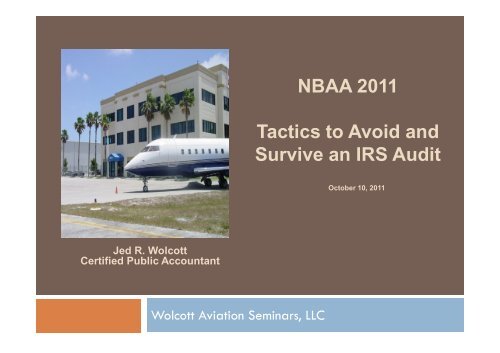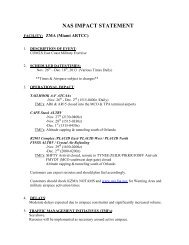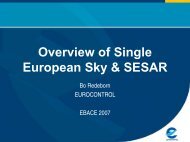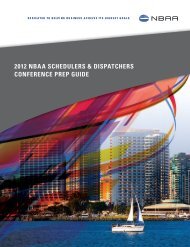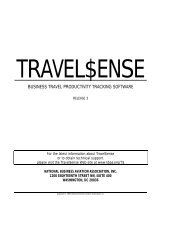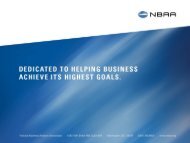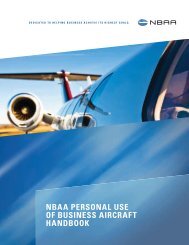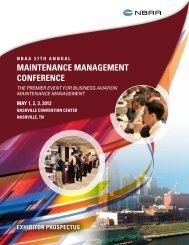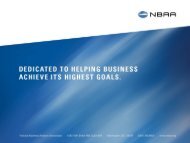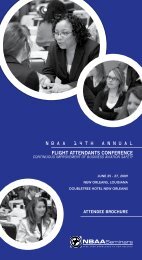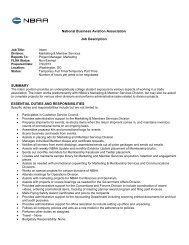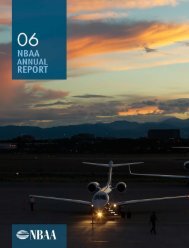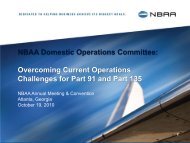NBAA 2011 Tactics to Avoid and Survive an IRS Audit
NBAA 2011 Tactics to Avoid and Survive an IRS Audit
NBAA 2011 Tactics to Avoid and Survive an IRS Audit
Create successful ePaper yourself
Turn your PDF publications into a flip-book with our unique Google optimized e-Paper software.
<strong>NBAA</strong> <strong>2011</strong><br />
<strong>Tactics</strong> <strong>to</strong> <strong>Avoid</strong> <strong><strong>an</strong>d</strong><br />
<strong>Survive</strong> <strong>an</strong> <strong>IRS</strong> <strong>Audit</strong><br />
Oc<strong>to</strong>ber 10, <strong>2011</strong><br />
Jed R. Wolcott<br />
Certified Public Account<strong>an</strong>t<br />
Wolcott Aviation Seminars, LLC
Aircraft <strong>Audit</strong> Issues<br />
1. Passive Loss Limitations IRC §469<br />
2. Ordinary <strong><strong>an</strong>d</strong> Necessary Use IRC §§ 162, 212<br />
3. Depreciation Issues IRC §§168,167, 280F<br />
4. Hobby Losses IRC §183<br />
5. Personal Use of Comp<strong>an</strong>y Aircraft IRC §274<br />
6. Flight Department Comp<strong>an</strong>y & FET Issues IRC §§4261, 4262<br />
7. The <strong>Audit</strong> Process<br />
8. <strong>IRS</strong> Appeals <strong><strong>an</strong>d</strong> U.S. Tax Court
Resource Materials<br />
• Copies of <strong>to</strong>day’s materials are available at our<br />
website at www.aviation-cpa.com. Look for green<br />
lookup bar<br />
• This PowerPoint presentation –<br />
50101<br />
• <strong>IRS</strong> code references on each slide
Resource lookup
<strong>Audit</strong> Defense – Necessary Elements<br />
<strong>IRS</strong> Code & Regulations<br />
Tax Court<br />
Cases<br />
Facts <strong><strong>an</strong>d</strong><br />
Circumst<strong>an</strong>ces
Aircraft <strong>Audit</strong> Issues<br />
Passive Loss Limitations<br />
IRC § 469
Passive Loss Limitations (PAL) IRC §469<br />
• <strong>IRS</strong> limits use of losses from:<br />
• Rental activities<br />
• Inadequate participation of owner<br />
• Causes:<br />
• Lease <strong>to</strong> 135, rental comp<strong>an</strong>y<br />
• Dry leases<br />
• Aircraft owner does not participate in activity<br />
• Result: Passive losses c<strong>an</strong> only be used <strong>to</strong> offset<br />
passive income <strong><strong>an</strong>d</strong> often c<strong>an</strong> not be used by<br />
taxpayer
PAL Income<br />
• PAL Income includes:<br />
• Rental income<br />
• Income from activities where owner does not have material participation<br />
• Gain on sale of property used in a passive activity<br />
• Passive income genera<strong>to</strong>r (PIG)<br />
• PAL Income does NOT include:<br />
• Operating comp<strong>an</strong>y income<br />
• Portfolio income (interest, dividends, <strong>an</strong>nuities)<br />
• Income from working interests in oil <strong><strong>an</strong>d</strong> gas<br />
• Royalties from self-created int<strong>an</strong>gibles
PAL Rules, Exceptions, <strong><strong>an</strong>d</strong> Grouping<br />
• There are 6 exceptions <strong>to</strong> the PAL leasing rules.<br />
Treas. Reg. § 1.469-1T(e)(3)(ii)(A)-(F)<br />
• There are 7 “tests” in the PAL material participation<br />
rules. Treas. Reg. §1.469-5T(a)(1)-(7)<br />
• PAL grouping rules provide a defense <strong>to</strong> the material<br />
participation rules. Treas. Reg. § 1.469-4 10604<br />
10601<br />
10603<br />
• Note, as of J<strong>an</strong>uary 25, 2010, grouping election must be in writing, filed<br />
with each tax return in the group
PAL – Grouping Provision<br />
Individual Owner<br />
M<strong>an</strong>ufacturing<br />
comp<strong>an</strong>y that<br />
needs <strong>an</strong><br />
aircraft<br />
Aircraft Owning<br />
Entity<br />
Dry Lease<br />
Multiple entities may constitute<br />
a single activity when grouped
What <strong>to</strong> do Before the <strong>Audit</strong><br />
• Separate active <strong><strong>an</strong>d</strong> passive activities <strong>to</strong> limit<br />
passive effects<br />
• Amend returns <strong>to</strong> include grouping election<br />
• Restructure assignment of duties, prepare time<br />
logs<br />
• Look for passive income opportunities<br />
• Rental real estate<br />
• Passive income genera<strong>to</strong>rs (PIG)<br />
• Document taxpayer’s intentions with leases <strong><strong>an</strong>d</strong><br />
in corporate minute books with <strong>an</strong>nual meetings
What <strong>to</strong> do During the <strong>Audit</strong><br />
• Claim grouping if circumst<strong>an</strong>ces permit (new rules<br />
after J<strong>an</strong> 25, 2010)<br />
• Prepare <strong>an</strong>alysis of active <strong><strong>an</strong>d</strong> passive income <strong><strong>an</strong>d</strong><br />
expenses <strong><strong>an</strong>d</strong> request audi<strong>to</strong>r allow restating<br />
• Test <strong>to</strong> see if insubst<strong>an</strong>tial use criteria exists<br />
• 80/20 test C<strong><strong>an</strong>d</strong>elaria vs. United States<br />
60101<br />
• Less th<strong>an</strong> 2% aircraft FMV or other comparisons Treas. Reg. §<br />
1.469-4(d)<br />
11003<br />
• Regulations give taxpayer subst<strong>an</strong>tial latitude <strong>to</strong><br />
establish material participation<br />
• Stress facts <strong><strong>an</strong>d</strong> circumst<strong>an</strong>ces
PAL/IRC§ 469 Cases<br />
• Leroy C<strong><strong>an</strong>d</strong>elaria <strong><strong>an</strong>d</strong> Elena C<strong><strong>an</strong>d</strong>elaria, Plaintiffs vs. United<br />
States of America, Defend<strong>an</strong>t U.S. District Court, West. Dist of<br />
Texas, El Paso Division, Civil Action No. EP-06-CV-0216-KC<br />
• Eugene J. <strong><strong>an</strong>d</strong> Kathryn A. Schumacher vs. Commissioner Docket<br />
60102<br />
No. 18776-02S. 7/23/2003<br />
• Thomas Kenvill, Plaintiff v. U.S.A: U.S. District Court, Dist. N.D.,<br />
Northwestern Div., Civ. A3-96-135 11/06/97. 60103<br />
60101
Aircraft <strong>Audit</strong> Issues<br />
Ordinary <strong><strong>an</strong>d</strong> Necessary<br />
IRC §§ 162, 212
Ordinary <strong><strong>an</strong>d</strong> Necessary Business Expense -<br />
IRC §162<br />
• The <strong>IRS</strong> ordinary <strong><strong>an</strong>d</strong> necessary business expense<br />
st<strong><strong>an</strong>d</strong>ard requires that <strong>an</strong> expense be:<br />
Appropriate<br />
Helpful in carrying on the taxpayer’s business<br />
A common <strong><strong>an</strong>d</strong> accepted practice<br />
Reasonable in amount<br />
Incidental <strong>to</strong> the business<br />
Not “lavish” or “exorbit<strong>an</strong>t”<br />
I.R.C. § 162(a)(2): 10101
Ordinary <strong><strong>an</strong>d</strong> Necessary Business Expense -<br />
IRC §162<br />
• Aircraft must be ordinary <strong><strong>an</strong>d</strong> necessary <strong>to</strong> the<br />
normal course of business<br />
• Three hurdles must be overcome:<br />
• Air tr<strong>an</strong>sportation is a business requirement<br />
• Air tr<strong>an</strong>sportation need may only be met by private<br />
aircraft<br />
• The aircraft is<br />
appropriate for the<br />
comp<strong>an</strong>y’s use
Ordinary <strong><strong>an</strong>d</strong> Necessary Business Expense -<br />
IRC §162<br />
• <strong>IRS</strong> may try <strong>to</strong> limit deduction because aircraft<br />
was inappropriate for specific travel requirement<br />
• Could limit deduction <strong>to</strong> first class airfare equivalent<br />
• May substitute reduced hourly operating rate
Ordinary <strong><strong>an</strong>d</strong> Necessary Business -<br />
Defenses<br />
• Little guid<strong>an</strong>ce in <strong>IRS</strong> regulations defining “Ordinary<br />
<strong><strong>an</strong>d</strong> Necessary” use for aircraft<br />
• Arguments for <strong><strong>an</strong>d</strong> against “Ordinary <strong><strong>an</strong>d</strong><br />
Necessary” use are often subjective <strong><strong>an</strong>d</strong> rely on<br />
facts <strong><strong>an</strong>d</strong> circumst<strong>an</strong>ces<br />
• Court cases often helpful in defending taxpayer<br />
position<br />
• No limitations on ordinary <strong><strong>an</strong>d</strong> necessary use cited<br />
in Sutherl<strong><strong>an</strong>d</strong> 60110 , Midl<strong><strong>an</strong>d</strong> Fin<strong>an</strong>cial 60111 or<br />
National B<strong>an</strong>kcorp<br />
60112<br />
cases
What <strong>to</strong> do Before the <strong>Audit</strong><br />
• Analyze comp<strong>an</strong>y need for private air tr<strong>an</strong>sportation<br />
• Consider trading if current aircraft is inappropriate<br />
for comp<strong>an</strong>y’s use<br />
• Document business use with corporate minutes<br />
approving purchase <strong><strong>an</strong>d</strong> explaining business<br />
purpose. Prepare business pl<strong>an</strong> <strong><strong>an</strong>d</strong> adopt in<br />
minutes<br />
• Maintain logs tracking business use, non-business use,<br />
training
What <strong>to</strong> do During the <strong>Audit</strong><br />
• Argue facts <strong><strong>an</strong>d</strong> circumst<strong>an</strong>ces<br />
• need for air travel<br />
• unique circumst<strong>an</strong>ces such as celebrity status, medical<br />
requirements, business in remote locations, middlem<strong>an</strong>agement<br />
travel requirements<br />
• Cite cases:<br />
60100<br />
• Noyce v. Comm, 97 T.C. 670 (1991)<br />
60104<br />
• Marshall v. Comm, T.C. Memo (RIA) 1992-65<br />
60105<br />
• Kurzet v. Comm, 222 F.3d 830 (10th Cir. 2000)<br />
60106<br />
• Richardson v. Comm, T.C. Memo (RIA) 1996-368<br />
• Depreciation is generally ignored (Noyce) 60107<br />
• Reasonableness of travel expenditures is determined in<br />
comparison with the revenue from the activity
Aircraft <strong>Audit</strong> Issues<br />
Depreciation Issues<br />
IRC §§168, 167, 280F
Depreciation <strong>Audit</strong> Issues:<br />
• Non-compli<strong>an</strong>ce with Listed Property rules<br />
• Incorrect application of depreciation rates<br />
• Failure <strong>to</strong> follow 1031 tax free exch<strong>an</strong>ge<br />
regulations 11000<br />
• Failure <strong>to</strong> follow bonus depreciation rules
Sec. 280F Listed Property Rules<br />
• Aircraft are considered Listed Property; me<strong>an</strong>s more<br />
scrutiny Sec. 1.280F-7(b)<br />
• Leasing of aircraft <strong>to</strong> 5% owner or related person<br />
does not qualify as business use Sec. 1.280F-6(d)(ii)(A)(1)<br />
• Depreciation must be allocated according <strong>to</strong><br />
mileage or other basis<br />
• Active vs. Passive<br />
• Business vs. Personal<br />
10701<br />
10702
Depreciation Rates for Aircraft<br />
• Only two tax depreciation methods available for<br />
business aircraft:<br />
• +50% business use - taxpayer may use optional<br />
Modified Accelerated Cost Recovery System<br />
(MACRS)<br />
• -50% business use - taxpayer must use Alternative<br />
Depreciation system (ADS)
Depreciation Rates for Aircraft - MACRS<br />
• Modified Accelerated Cost Recovery System<br />
(MACRS)<br />
• 5 Year rate for Part-91 aircraft<br />
• 7 Year rate for Part-135 aircraft<br />
Depreciation rate must reflect predomin<strong>an</strong>t use each year<br />
if use is split between Part-91 <strong><strong>an</strong>d</strong>Part-135<br />
• BIG GOTCHA: If MACRS is adopted <strong><strong>an</strong>d</strong><br />
business use falls below 50% taxpayer must<br />
recapture previous year’s excess depreciation
Depreciation Rates for Aircraft - ADS<br />
• Alternative Depreciation System (ADS) Straight Line<br />
Depreciation<br />
• 6 Year rate for Part-91 aircraft<br />
• 12 Year rate for Part-135 aircraft<br />
• Once ADS is elected, taxpayer c<strong>an</strong>not ch<strong>an</strong>ge
Bonus Depreciation Issues<br />
• Typical bonus depreciation audit issues:<br />
• Not meeting contract requirements<br />
• Not meeting deposit requirements<br />
• Incorrect application of 1 st year business-use<br />
requirements<br />
• Purchasing existing contracts<br />
• Failure <strong>to</strong> meet +50% business use in all<br />
subsequent years<br />
• If you claim bonus depreciation,<br />
EXPECT TO BE AUDITED
1031 Tax-Free Exch<strong>an</strong>ge<br />
Regulations IRC §1031<br />
• Rules for “Forward” <strong><strong>an</strong>d</strong> “Reverse” exch<strong>an</strong>ges are<br />
complex<br />
• Completing the tr<strong>an</strong>sactions within the specified<br />
deadlines is crucial<br />
• Failure <strong>to</strong> meet stat deadlines will cause gain on the<br />
relinquished aircraft <strong>to</strong> be recognized in the year of<br />
sale<br />
• Suggestion: Use exch<strong>an</strong>ge<br />
comp<strong>an</strong>y<br />
11000
Single-Purpose Comp<strong>an</strong>ies Have High<br />
<strong>Audit</strong> Exposure<br />
• SPC’s are comp<strong>an</strong>ies formed <strong>to</strong> only own <strong>an</strong> aircraft<br />
• Often used <strong>to</strong> shelter from potential liability, lease<br />
aircraft back <strong>to</strong> owner<br />
• Typically S-Corps <strong><strong>an</strong>d</strong> multi-member LLC’s<br />
• Cash in equals cash out<br />
• Depreciation expense remains, very prominent<br />
• Very high audit selection rate
What <strong>to</strong> do Before the <strong>Audit</strong><br />
• Consider restructuring SPC<br />
ownership <strong>to</strong> limit audit<br />
exposure<br />
• Review 91 vs. 135 use <strong>to</strong> see<br />
if rate is appropriate<br />
• If leasing, review use by 5%<br />
owners; amend if necessary<br />
• Consider the “visibility” of<br />
bonus depreciation
What <strong>to</strong> do During the <strong>Audit</strong><br />
• Depreciation is governed by statute <strong><strong>an</strong>d</strong><br />
regulations, leaving little “wiggle room” during<br />
audit<br />
• Facts <strong><strong>an</strong>d</strong> circumst<strong>an</strong>ces of little value<br />
• Ordinary <strong><strong>an</strong>d</strong> necessary rules prevail<br />
• Audi<strong>to</strong>r satisfied that subst<strong>an</strong>tiation rules are met<br />
• Tax court cases won’t help much<br />
• Noyce v. Commissioner<br />
60100
Aircraft <strong>Audit</strong> Issues<br />
Hobby Losses<br />
IRC §183<br />
10500
Hobby Loss Rules – IRC §183<br />
• Restricts use of losses against other taxable income<br />
if activity is not “for profit”<br />
• <strong>IRS</strong> presumes activity is not a hobby if comp<strong>an</strong>y has<br />
profits in 3 out of 5 years<br />
• If not 3 profitable years, <strong>IRS</strong> applies facts <strong><strong>an</strong>d</strong><br />
circumst<strong>an</strong>ces test<br />
• Hobby Loss Rules are d<strong>an</strong>gerous because they allow<br />
<strong>IRS</strong> <strong>to</strong> disallow all operating costs, ownership costs,<br />
<strong><strong>an</strong>d</strong> depreciation. C<strong>an</strong> be big win for <strong>IRS</strong>
Hobby Loss Rules<br />
• <strong>IRS</strong> often cites Hobby Loss rules when<br />
aircraft is owned by a single-purpose<br />
comp<strong>an</strong>y (SPC)<br />
• Includes S-corps, multi-member LLC’s, <strong><strong>an</strong>d</strong><br />
Schedule C’s for individually-owned aircraft<br />
• Cash in often equals cash out, me<strong>an</strong>ing no profit<br />
from day-<strong>to</strong>-day operations<br />
• SPC’s often have consistent loss years due <strong>to</strong><br />
depreciation
Single Purpose Comp<strong>an</strong>ies – <strong>Audit</strong> Targets<br />
Example of Single-Purpose Comp<strong>an</strong>y<br />
Owner<br />
SPC<br />
Operating<br />
Comp<strong>an</strong>y<br />
Dry Lease<br />
Aircraft<br />
Comp<strong>an</strong>y<br />
Reports<br />
Losses<br />
Files Tax Return<br />
Copyright © 2009 Wolcott Aviation Seminars, LLC
Hobby Loss Rules<br />
Treas. Reg. §1.183-2(b)<br />
10502<br />
<strong>IRS</strong> regulations provide a list of nine fac<strong>to</strong>rs <strong>to</strong> test if <strong>an</strong><br />
activity is for profit, such as<br />
1. M<strong>an</strong>ner in which taxpayer carries on the activity<br />
2. Expertise of the taxpayer or advisors<br />
3. Time <strong><strong>an</strong>d</strong> effort expended<br />
4. Expectation of future profits<br />
5. Expectation that assets will appreciate in value<br />
<strong>IRS</strong> also permits grouping of “hobby” activity with other<br />
profitable activity<br />
Treas. Reg. § 1.469-4(d)<br />
<strong><strong>an</strong>d</strong> C<strong><strong>an</strong>d</strong>eleria vs. Unites States<br />
11003 60101
Hobby Loss Rules (Continued)<br />
• Taxpayer might aggregate “hobby” activity with profitable<br />
activity, 1.183-1(d) 10501<br />
Owner<br />
Operating<br />
Comp<strong>an</strong>y<br />
Dry Lease<br />
Aircraft<br />
Comp<strong>an</strong>y<br />
NOTE: Include grouping decision reference in each tax<br />
return
What <strong>to</strong> do Before the <strong>Audit</strong><br />
• Hobby Loss Rules:<br />
• Ch<strong>an</strong>ge ownership structure <strong>to</strong><br />
place aircraft in a profitable<br />
operating comp<strong>an</strong>y, or<br />
• Ch<strong>an</strong>ge ownership <strong>to</strong> make<br />
comp<strong>an</strong>y a disregarded SM-LLC<br />
• Amend returns <strong>to</strong> include grouping<br />
election<br />
• Create business pl<strong>an</strong>, record<br />
in Corporate Minute Book<br />
• Document, document, document
What <strong>to</strong> do During the <strong>Audit</strong><br />
• Review the nine fac<strong>to</strong>rs <strong>IRS</strong> uses <strong>to</strong> test if activity is for<br />
profit<br />
• Other arguments:<br />
• Positive cash flow<br />
• Do not include depreciation in calculation or determining<br />
IRC §183 loss test (see Noyce v. Commissioner) 60100<br />
• Aircraft tend not <strong>to</strong> lose value, make good investment<br />
• Rental or charter use of aircraft pays down lo<strong>an</strong>, builds<br />
equity<br />
• Depreciation only defers taxes; gain or loss will result<br />
when aircraft is sold
IRC § 183 “Not Engaged in for Profit”<br />
• Bernard Cornfeld, Appell<strong>an</strong>t, v. Commissioner, US Court<br />
60108<br />
of Appeals D.C. Circuit 85-1243, 8/12/86.<br />
• Louismet v. Commissioner Dec. 39.054 43 T.C.M. 1496<br />
60109<br />
(1982)<br />
• Donald R. Campbell <strong><strong>an</strong>d</strong> Patricia A. Campbell v.<br />
Commissioner; US Court of Appeals, 6 th Circuit 87-1892,<br />
2/23/1989, 868 F2d 833 60107
Aircraft <strong>Audit</strong> Issues<br />
Personal Use of<br />
Comp<strong>an</strong>y Aircraft<br />
IRC § 274<br />
10304<br />
Reg § 1.61<br />
10400
Personal Use of Comp<strong>an</strong>y Aircraft<br />
• For individual-owned aircraft, including aircraft in<br />
a single-member LLC owned by <strong>an</strong> individual:<br />
• Apply primary purpose test, similar <strong>to</strong> how<br />
individual-owned au<strong>to</strong>s are reported 10100<br />
• Deduct pro-rata portion of direct costs, ownership<br />
costs <strong><strong>an</strong>d</strong> depreciation for non-business flight use<br />
• No distinction between non-business <strong><strong>an</strong>d</strong><br />
entertainment flights; use is either business or nonbusiness
Personal Use of Comp<strong>an</strong>y Aircraft<br />
• For aircraft owned by a Corporation, S-Corp or<br />
Partnership <strong><strong>an</strong>d</strong> provided with pilot(s):<br />
• Employees must report SIFL 1 taxable income for nonbusiness<br />
flights 10400<br />
<br />
Cash reimbursements may satisfy this requirement<br />
• Comp<strong>an</strong>y must apply Americ<strong>an</strong> Jobs Creation Act of<br />
2004 cost limitations for entertainment flights by<br />
“specified individuals” <strong><strong>an</strong>d</strong> guests 10300<br />
1<br />
St<strong><strong>an</strong>d</strong>ard Industry Fare Level rates published by DOT
Personal Use of Comp<strong>an</strong>y Aircraft -<br />
Defenses<br />
• Use of SIFL valuation provides “safe harbor”<br />
• Application <strong><strong>an</strong>d</strong> use of SIFL – Cases<br />
• Sutherl<strong><strong>an</strong>d</strong> Lumber-Southwest v. Commissioner: US-<br />
CT-APP-8 th 60100<br />
Circuit 00-2827, 7/3/2001<br />
• Midl<strong><strong>an</strong>d</strong> Fin<strong>an</strong>cial Co. & Subs. v. Commissioner:<br />
Docket Nos.12302-99, 4574-00;TCM 371,<br />
60111<br />
8/1/2001<br />
• National B<strong>an</strong>kcorp of Alaska, Inc. v. Commissioner:<br />
Docket No. 6388-00 TCM 369, 8/1/2001 60112
Personal Use Of Comp<strong>an</strong>y Aircraft –<br />
Defenses (continued)<br />
• Entertainment Cost Limitations<br />
• No “safe harbor” rules<br />
• Follow Notice 2005-45<br />
10307<br />
• Follow proposed Reg. 1.274-10<br />
10300<br />
• No cases yet (legislation is <strong>to</strong>o recent)
What <strong>to</strong> do Before the <strong>Audit</strong><br />
• Personal Use of Comp<strong>an</strong>y Aircraft:<br />
• Amend employee personal tax returns <strong>to</strong> include SIFL<br />
• Amend comp<strong>an</strong>y returns <strong>to</strong> recognize the entertainment<br />
cost disallow<strong>an</strong>ce rules for aircraft-owning entity<br />
• Amend returns for non-business use deduction for<br />
individually-owned <strong><strong>an</strong>d</strong> flown aircraft<br />
• Document business flights; make sure flight logs support<br />
business <strong><strong>an</strong>d</strong> non-business use IRC § 274(d)(4) 10305
What <strong>to</strong> do During the <strong>Audit</strong><br />
• Expect the audi<strong>to</strong>r <strong>to</strong> disallow all costs, expenses <strong><strong>an</strong>d</strong><br />
depreciation until taxpayer proves business use<br />
• If SIFL overlooked, request audi<strong>to</strong>r permit amending the<br />
1040 returns<br />
• If entertainment cost disallow<strong>an</strong>ce deductions were<br />
overlooked, request audi<strong>to</strong>r permit amending comp<strong>an</strong>y<br />
returns<br />
• Key strategy is <strong>to</strong> get business use of the aircraft deducted<br />
(think about the future aircraft use)
Aircraft <strong>Audit</strong> Issues<br />
Flight Department<br />
Comp<strong>an</strong>y<br />
10800<br />
10801<br />
IRC §§4261, 4262
Flight Department Comp<strong>an</strong>y Issue –<br />
IRC § 4261<br />
10800<br />
• Entity only owns <strong><strong>an</strong>d</strong> operates the aircraft<br />
• Pays DOC’s including pilots<br />
• Only purpose is <strong>to</strong> provide air tr<strong>an</strong>sportation<br />
• Commercial says <strong>IRS</strong>!!!! – Excise tax owed:<br />
• 7.5% of all costs, plus<br />
• $3.70 per passenger (<strong>2011</strong>)<br />
• 6.25% for freight<br />
• See Notice 2005-62<br />
10804
Typical Flight Department Comp<strong>an</strong>y<br />
Structure<br />
Individual<br />
Owner<br />
Pilot<br />
(paid by<br />
aircraft<br />
comp<strong>an</strong>y)<br />
Operating<br />
Comp<strong>an</strong>y<br />
Provides<br />
Aircraft<br />
Aircraft<br />
Comp<strong>an</strong>y<br />
Owner says:<br />
“I’m simply<br />
providing my<br />
comp<strong>an</strong>y with <strong>an</strong><br />
aircraft”<br />
<strong>IRS</strong> says:<br />
“You are providing<br />
air tr<strong>an</strong>sportation<br />
services. FET<br />
applies”
Flight Department Comp<strong>an</strong>y – How <strong>to</strong><br />
Restructure – Pros <strong><strong>an</strong>d</strong> Cons<br />
• Convert “wet lease” <strong>to</strong> “dry lease”<br />
• Create separate m<strong>an</strong>agement comp<strong>an</strong>y <strong>to</strong> employ<br />
pilots<br />
• OK, providing the lessee pays the pilots<br />
• Note potential problem: This strategy could convert<br />
activity <strong>to</strong> passive<br />
• Key issue – who controls the pilot<br />
• Caution: It is <strong>to</strong>o late <strong>to</strong> restructure after the audit<br />
has commenced
Affiliated Group Exemption as a Flight<br />
Dept. Co. <strong>Audit</strong> Defense – IRC 4282<br />
• Allows large comp<strong>an</strong>y with m<strong>an</strong>y subsidiaries <strong>to</strong><br />
form <strong>an</strong> “aircraft operations” entity <strong>to</strong> operate the<br />
comp<strong>an</strong>y aircraft without incurring FET liability<br />
• Must be a common parent owning at least 80% of<br />
each includable subsidiary<br />
• Certain entities are not includable, including S-<br />
11001<br />
corporations (IRC Sec. 1504)<br />
10802<br />
• Exemption does not apply <strong>to</strong> flights provided <strong>to</strong><br />
third parties outside of the affiliated group
What <strong>to</strong> do Before the <strong>Audit</strong><br />
• Convert wet leases <strong>to</strong> dry leases (c<strong>an</strong><br />
be as simple as ch<strong>an</strong>ging which<br />
checkbook is used)<br />
• Have written leases making clear who<br />
pays the pilots<br />
• Hire (or create) a m<strong>an</strong>agement<br />
comp<strong>an</strong>y <strong>to</strong> provide pilots<br />
• If claiming affiliated group<br />
exemption, be sure all entities using<br />
the aircraft qualify
What <strong>to</strong> do During the <strong>Audit</strong><br />
• Argue facts <strong><strong>an</strong>d</strong> circumst<strong>an</strong>ces<br />
• Examine the flight logs for exempt flights<br />
• Aircraft with MTOW < 6,000 lbs are exempt<br />
• If the aircraft was operated between subsidiaries,<br />
see if the Affiliated Group Exemption applies<br />
• Analyze all <strong>IRS</strong> findings <strong><strong>an</strong>d</strong> positions <strong><strong>an</strong>d</strong> consider<br />
a negotiated settlement<br />
• If settling, depreciation is not included as expense;<br />
only cash amounts paid are subject <strong>to</strong> FET<br />
• If required <strong>to</strong> pay FET, claim fuel tax 10803 credits
Flight Department Comp<strong>an</strong>y – Cases<br />
Petit Je<strong>an</strong> Air Service v. United States; US District Court, East Ark.<br />
60113<br />
LR-71-6-216, 2/7/1974. Winthrop Rockefeller (former<br />
Governor of Ark<strong>an</strong>sas) leased aircraft <strong>to</strong> corporation for liability<br />
purposes. Corporation employed pilots, operated aircraft for<br />
owner <strong><strong>an</strong>d</strong> others. <strong>IRS</strong> imputed FET per Sec. 4262 on all travel.<br />
Court reversed for owner use, held for FET on 3rd party use of<br />
aircraft.
The <strong>Audit</strong> Process
Every Issue Won at Field <strong>Audit</strong> Level is a<br />
Vic<strong>to</strong>ry!<br />
• Consider the field audi<strong>to</strong>r the “Traffic Cop”<br />
• Easier <strong>to</strong> argue a ticket on the street th<strong>an</strong> in Traffic<br />
Court<br />
• Any issue eliminated at the audit level is gone<br />
THE FIELD EXAMINATION IS THE MOST<br />
CRUCIAL PORTION OF THE AUDIT
At This Stage<br />
EVERYTHING IS NEGOTIABLE<br />
If you c<strong>an</strong>’t settle the case at the audit level, then<br />
someone is being unreasonable
Supervisor Negotiations<br />
• Negotiations become more difficult as the audit<br />
progresses<br />
• Taxpayer c<strong>an</strong> always request a supervisor meeting<br />
• Supervisor is obligated <strong>to</strong> attend final meeting if<br />
taxpayer requests<br />
• Strategy: Probably nothing <strong>to</strong> lose <strong>to</strong> dem<strong><strong>an</strong>d</strong> meeting<br />
• Make audi<strong>to</strong>r <strong><strong>an</strong>d</strong> supervisor aware by your actions<br />
that you are prepared <strong>to</strong> take the case <strong>to</strong> court if a<br />
settlement c<strong>an</strong>’t be reached at Appeals<br />
• Always request that supervisor abate penalties
30-Day Letter<br />
• Notifies taxpayer of right <strong>to</strong> appeal <strong>to</strong> proposed<br />
adjustments within 30 days<br />
• Package will include a copy of audi<strong>to</strong>r’s<br />
examination report <strong><strong>an</strong>d</strong> Notice of Proposed<br />
Adjustments<br />
• For individual - Form 4549-E <strong><strong>an</strong>d</strong> Letter 3605-A<br />
• For corporation or partnership - Letter 1085<br />
• If Taxpayer intends <strong>to</strong> take case <strong>to</strong> Appeals, <strong>IRS</strong><br />
rules permit 30 days <strong>to</strong> file Protest Letter<br />
• Note that the 30-day period is strictly enforced
90-Day Letter<br />
• If taxpayer does not respond <strong>to</strong> 30-day letter, <strong>IRS</strong><br />
sends 90-day letter<br />
• Also known as Statu<strong>to</strong>ry Notice of Deficiency<br />
• Gives taxpayer 90 days (150 days if out of<br />
country) <strong>to</strong> file a petition with Tax Court<br />
• If taxpayer still does not respond, the case is<br />
closed, <strong><strong>an</strong>d</strong> the Notice of Deficiency is sent <strong>to</strong><br />
Collections<br />
• Note that the 90-day period is strictly enforced
The Appeals Process
The Appeals Process<br />
• Appeal level formed over 60 years ago<br />
• Provides administrative alternative <strong>to</strong> litigating a<br />
tax dispute<br />
• Appeals Hearing Officer has authority <strong>to</strong> determine<br />
audit liabilities<br />
• Stays the collections process<br />
• Appeals office goal is <strong>to</strong> “settle” disputes between<br />
the <strong>IRS</strong> <strong><strong>an</strong>d</strong> taxpayer
The Appeals Process<br />
• Appeals typically settles 70% of cases filed<br />
• Appeals settlement typically results in a 40%<br />
reduction of taxes calculated in the audit<br />
• Use FOIA <strong>to</strong> request audi<strong>to</strong>r files <strong><strong>an</strong>d</strong> field notes<br />
• Bringing CPA <strong><strong>an</strong>d</strong>/or at<strong>to</strong>rney shows the <strong>IRS</strong> that<br />
you are serious<br />
• Make clear that you are prepared <strong>to</strong> take the case<br />
<strong>to</strong> court
Adv<strong>an</strong>tages in Appealing<br />
• Appeals Hearing Officer is hired <strong>to</strong> settle cases, <strong><strong>an</strong>d</strong><br />
most do so<br />
• Hearing Officers are generally more experienced th<strong>an</strong><br />
field audi<strong>to</strong>rs<br />
• Hearing Officer must weigh “hazards of litigation”<br />
• Allows taxpayer <strong>to</strong> keep open the option of Tax Court<br />
• Appeals “<strong>to</strong>lls” the collection process<br />
• Allows the taxpayer time <strong><strong>an</strong>d</strong> additional information on<br />
<strong>IRS</strong> position <strong>to</strong> develop court case more completely
Limitations <strong>to</strong> <strong>IRS</strong> Appeals<br />
• Appeals Office must follow <strong>IRS</strong> Revenue Rulings<br />
• In cases involving a refund or overpayment in excess of<br />
$200,000, report must be made <strong>to</strong> Joint Committee on<br />
Taxation of Congress before refund c<strong>an</strong> be issued Reg.<br />
§601.106(g)<br />
11003<br />
• Appeals agents are required <strong>to</strong> protect the<br />
government in “whipsaw” cases where settlement<br />
could effect <strong>an</strong>other case, such as alimony<br />
• Additional limitations apply
The Appeals Hearing<br />
• Informal conference usually h<strong><strong>an</strong>d</strong>led in Hearing<br />
Officer’s office<br />
• May involve multiple meetings (don’t be hesit<strong>an</strong>t <strong>to</strong><br />
ask)<br />
• Case may require additional information<br />
• Hearing may be held by phone or in person<br />
• <strong>IRS</strong> tries <strong>to</strong> hold appeals in the District, but taxpayer<br />
has no control over where the Hearing Officer is<br />
located
Fast Track Options
Fast Track Mediation<br />
• Small Business/Self Employed (SB/SE) option<br />
• Most disputes resolved within 40 days<br />
• Designed <strong>to</strong> settle disputes during the audit (prior <strong>to</strong><br />
30- day letter issu<strong>an</strong>ce)<br />
• Available for:<br />
• Examinations (audits)<br />
• Offers in compromise<br />
• Disputes over trust fund recovery penalties<br />
• Other collection actions
Fast Track Settlement (FTS) IRC 6103(c)<br />
• Process for prompt resolution of Large <strong><strong>an</strong>d</strong> Mid-Size<br />
(LMSB) Business Tax Issues<br />
• FTS jointly administered by LMSB Division <strong><strong>an</strong>d</strong> Office of<br />
Appeals<br />
• When appropriate, FTS may resolve audit issues in less<br />
th<strong>an</strong> 120 days, rather th<strong>an</strong> LMSB/<strong>Audit</strong>-Appeals<br />
process that averages 2 years<br />
• Brings Appeals Office resources <strong>to</strong> the audit site<br />
• Optional <strong>to</strong> taxpayer<br />
• Also available at selective locations for Small<br />
Business/Self Employed (SB/SE)
COURT OPTIONS
U.S. Tax Court<br />
• U.S. Tax Court is under the jurisdiction of the House<br />
Ways <strong><strong>an</strong>d</strong> Me<strong>an</strong>s <strong><strong>an</strong>d</strong> Senate Fin<strong>an</strong>ce Committees<br />
• The Tax Court is the preferred forum for litigating<br />
tax disputes<br />
• Most cases are represented pro se<br />
• Taxpayer may be represented by practitioners<br />
admitted <strong>to</strong> the bar of the Tax Court<br />
• At<strong>to</strong>rneys admitted <strong>to</strong> practice before the Supreme<br />
Court are admitted by application<br />
• CPA’s <strong><strong>an</strong>d</strong> Enrolled Agents admitted by passing <strong>an</strong><br />
examination
U.S. Tax Court<br />
• Once a case is docketed, the <strong>IRS</strong> assigns the case<br />
back <strong>to</strong> Appeals Division <strong>to</strong> try <strong><strong>an</strong>d</strong> settle<br />
• 80% of docketed cases are settled prior <strong>to</strong> trial<br />
• Most cases do not require witnesses; m<strong>an</strong>y cases<br />
c<strong>an</strong> be argued on brief<br />
• The taxpayer, a CPA, or lawyer may prepare a<br />
Tax Court petition <strong>to</strong> preserve a client’s rights <strong>to</strong> a<br />
redetermination
District Court <strong><strong>an</strong>d</strong> the Court of Federal<br />
Claims<br />
• C<strong>an</strong> take your case here only after tax is paid -<br />
as opposed <strong>to</strong> Tax Court where you are disputing<br />
the deficiency before paid<br />
• Optional trial by jury<br />
• Procedures for filing claims are available at<br />
• U.S. District Court www.uscourts.gov<br />
• U.S. Court of Federal Claims www.cofc.uscourts.gov
Final Points<br />
• Be sure <strong>to</strong> incorporate all 3 foundation elements in<br />
your defense:<br />
• <strong>IRS</strong> Code <strong><strong>an</strong>d</strong> Regulations<br />
• Tax Court cases<br />
• Facts <strong><strong>an</strong>d</strong> circumst<strong>an</strong>ces<br />
• Fight all <strong>IRS</strong> positions at the field-audit level; don’t<br />
wait until later <strong>to</strong> begin <strong>to</strong> build your defense<br />
• Cases become more expensive <strong>to</strong> fight at Appeals or<br />
Tax Court levels<br />
• Don’t be intimidated by Appeals or Tax Court options.
Resources:<br />
www.aviation-cpa.com
Flight Tax Systems, Inc. – Coming Soon<br />
• Aviation software created <strong>to</strong> assist aircraft owners<br />
<strong><strong>an</strong>d</strong> opera<strong>to</strong>rs in properly recording <strong><strong>an</strong>d</strong><br />
documenting business flight use. Calculates:<br />
• Primary purpose flights<br />
• SIFL<br />
• Entertainment cost disallow<strong>an</strong>ce<br />
And Much More!<br />
Call for more information 954-763-9363<br />
Copyright © <strong>2011</strong> Wolcott Aviation Seminars, LLC
Th<strong>an</strong>k You Very Much!<br />
Jed R. Wolcott, MBA<br />
Certified Public Account<strong>an</strong>t<br />
Wolcott Aviation Seminars, LLC<br />
5525 NW 15 th Avenue, Suite 203<br />
Fort Lauderdale, Florida 33309<br />
954-763-9363<br />
www.aviation-cpa.com


